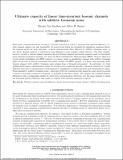Ultimate capacity of linear time-invariant bosonic channels with additive Gaussian noise
Author(s)
Roy Bardhan, Bhaskar; Shapiro, Jeffrey H
DownloadShapiro_Ultimate capacity.pdf (449.3Kb)
PUBLISHER_POLICY
Publisher Policy
Article is made available in accordance with the publisher's policy and may be subject to US copyright law. Please refer to the publisher's site for terms of use.
Terms of use
Metadata
Show full item recordAbstract
Fiber-optic communications are moving to coherent detection in order to increase their spectral efficiency, i.e., their channel capacity per unit bandwidth. At power levels below the threshold for significant nonlinear effects, the channel model for such operation a linear time-invariant filter followed by additive Gaussian noise is one whose channel capacity is well known from Shannon's noisy channel coding theorem. The fiber channel, however, is really a bosonic channel, meaning that its ultimate classical information capacity must be determined from quantum-mechanical analysis, viz. from the Holevo-Schumacher-Westmoreland (HSW) theorem. Based on recent results establishing the HSW capacity of a linear (lossy or amplifying) channel with additive Gaussian noise, we provide a general continuous-time result, namely the HSW capacity of a linear time-invariant (LTI) bosonic channel with additive Gaussian noise arising from a thermal environment. In particular, we treat quasi-monochromatic communication under an average power constraint through a channel comprised of a stable LTI filter that may be attenuating at all frequencies or amplifying at some frequencies and attenuating at others. Phase-insensitive additive Gaussian noise-associated with the continuous-time Langevin noise operator needed to preserve free-field commutator brackets is included at the filter output. We compare the resulting spectral efficiencies with corresponding results for heterodyne and homodyne detection over the same channel to assess the increased spectral efficiency that might be realized with optimum quantum reception.
Date issued
2016-03Department
Massachusetts Institute of Technology. Department of Electrical Engineering and Computer Science; Massachusetts Institute of Technology. Research Laboratory of ElectronicsJournal
Proceedings of SPIE--the Society of Photo-Optical Instrumentation Engineers
Publisher
SPIE
Citation
Roy Bardhan, Bhaskar, and Jeffrey H. Shapiro. Ultimate Capacity of Linear Time-Invariant Bosonic Channels with Additive Gaussian Noise. Proceedings of SPIE--the Society of Photo-Optical Instrumentation Engineers, San Francisco, California, United States, Edited by Hamid Hemmati and Don M. Boroson, 2016, p. 973910. © 2016 SPIE
Version: Final published version
ISSN
0277-786X
1996-756X